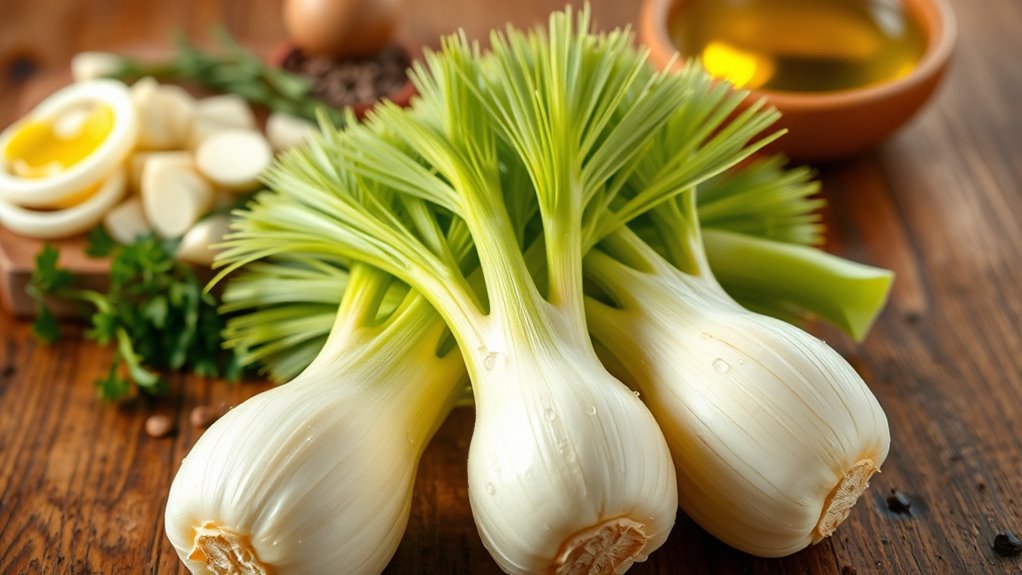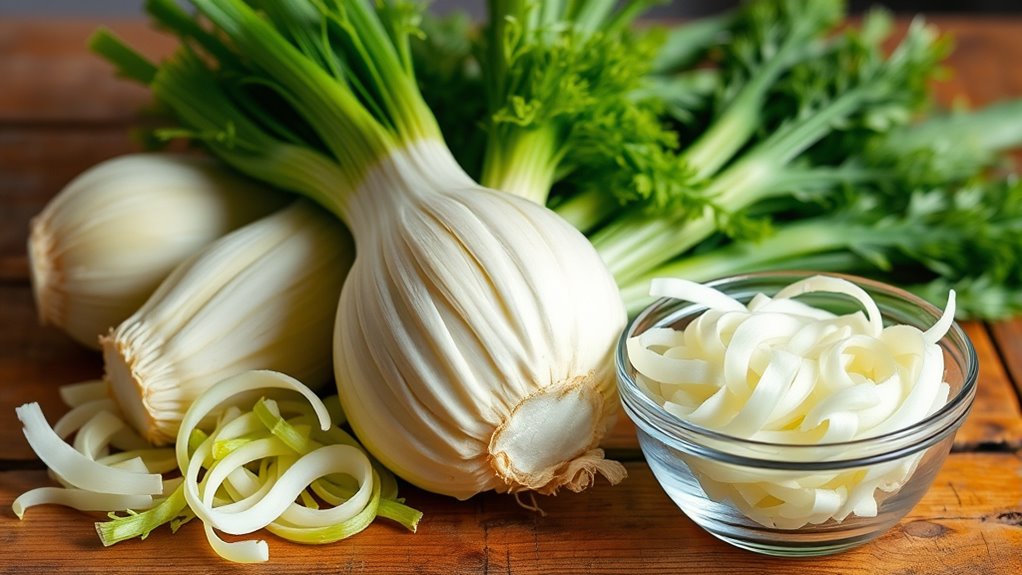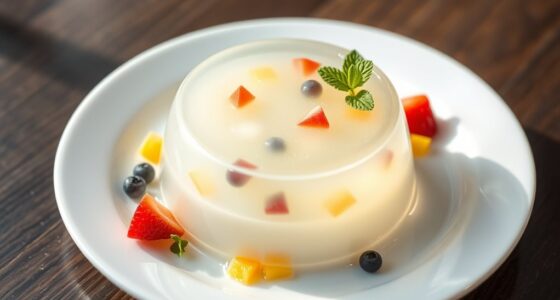In Italian cooking, fennel is valued for its versatility and aromatic qualities. You’ll find both the bulb, used roasted or in salads, and the feathery fronds adding aroma to dishes. Fennel seeds also feature in desserts like biscotti and sweets, providing a licorice-like flavor. Different varieties include Florence fennel and wild fennel, each bringing unique nuances. Exploring these options opens up a world of flavorful culinary possibilities that go beyond the basics.
Key Takeaways
- Fennel is a versatile ingredient in Italian cuisine, used in both savory dishes and desserts for its aromatic, slightly sweet flavor.
- The bulb is commonly roasted or sliced raw to enhance natural sweetness and aroma, often paired with olive oil, lemon, and herbs.
- Fennel seeds are used in baked goods like biscotti and cookies, imparting a licorice-like aroma and subtle spice.
- Variations include fresh fennel bulbs, seeds, and fennel pollen, each contributing unique flavors and uses in Italian recipes.
- Fennel’s flavor profile complements seafood, grilled meats, and sweet confections, making it a staple across diverse Italian dishes.

Have you ever wondered why fennel is such a cherished ingredient in Italian cuisine? Its versatility and unique flavor profile make it a staple in many traditional dishes. When you explore fennel’s uses, you quickly realize how this herb can add depth and aroma to both savory and sweet creations. One popular way to enjoy fennel is through fennel bulb roasting. By slicing the bulb and roasting it until tender and caramelized, you bring out its natural sweetness and subtle anise flavor. Roasted fennel pairs beautifully with olive oil, lemon, and herbs, making it an excellent side dish or a component in salads and pasta dishes. The process enhances its texture and flavor, transforming a simple vegetable into a culinary delight that complements everything from seafood to grilled meats. Cooking techniques also influence how fennel’s flavor develops during preparation, allowing for diverse culinary expressions.
Beyond the bulb, fennel seeds also play a crucial role in Italian desserts. You might not realize it, but fennel seed desserts are quite common in Italy, offering a fragrant and slightly sweet twist. These tiny seeds lend a warm, licorice-like aroma to baked goods like biscotti, cookies, and tarts. When used in desserts, fennel seeds provide a distinctive flavor that balances sweetness with a hint of aromatic spice. You’ll find recipes that incorporate fennel seeds into sweet pastries or even infused into syrups, elevating simple treats into memorable confections. The seeds can also be ground into a powder and sprinkled over desserts or mixed into batter, imparting a subtle complexity that’s hard to find elsewhere.
Frequently Asked Questions
How Do I Store Fresh Fennel to Maximize Shelf Life?
To store fresh fennel and maximize its shelf life, you should focus on proper fennel preservation techniques. Wrap the fennel bulbs loosely in a damp paper towel and place them in a perforated plastic bag in the refrigerator. This helps keep it fresh longer. Storing fennel properly prevents moisture loss and preserves its flavor. Check regularly and use within a week for the best quality.
Can Fennel Be Used in Desserts or Sweet Dishes?
Absolutely, you can use fennel in desserts or sweet dishes. Try fennel in fennel dessert recipes like fennel-infused panna cotta or candied fennel bulbs for a unique flavor. Sweet fennel dishes highlight its subtle licorice notes, adding depth to pastries or fruit compotes. Its aromatic qualities work well in both traditional and innovative sweets, giving your desserts a sophisticated, aromatic twist. Don’t hesitate to experiment with fennel in your next sweet creation!
What Are the Health Benefits of Consuming Fennel Regularly?
Picture a garden bursting with liveliness—that’s what fennel’s health benefits bring to your life. By including it regularly, you boost your digestive health and enjoy its antioxidant properties, helping fight off free radicals. Fennel’s natural compounds soothe your stomach and support immune function. With each crunchy bite, you nourish your body and energize your day, turning simple fennel into a powerful ally for your well-being.
Are There Any Common Substitutes for Fennel in Recipes?
If you’re looking for herb alternatives or vegetable swaps for fennel, you have several options. You can use celery or anise seeds to mimic fennel’s licorice flavor, or try leeks and green onions for a similar aromatic quality. These substitutes work well in recipes where fennel’s texture and flavor are key, helping you maintain the dish’s essence without the actual fennel.
How Do I Select the Best Fennel Bulbs at the Market?
When selecting fennel bulbs at the market, look for fresh, firm bulbs with vibrant green fronds. Avoid bulbs that feel soft, look wilted, or have dark spots, as these signs of poor fennel bulb freshness indicate they’re past ripe fennel stage. Choose bulbs that are heavy for their size, which suggests moisture and ripeness. Fresh fennel should be crisp and aromatic, ensuring you get the best flavor for your dishes.
Conclusion
Now that you know the different varieties and uses of fennel in Italian cooking, you’re ready to bring fresh flavors to your table. Don’t be afraid to try new recipes—after all, variety is the spice of life. With fennel’s versatility, you can turn everyday dishes into something special. So go ahead, give it a shot—sometimes, the proof is in the pudding, and your culinary creations will speak for themselves.









